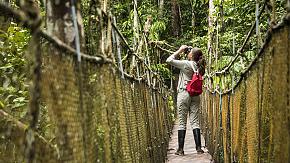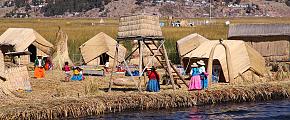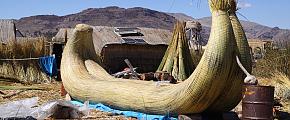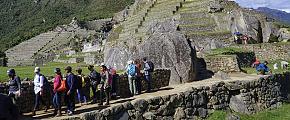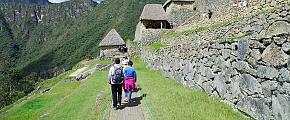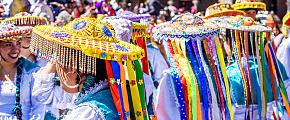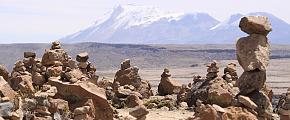Peru in January 2026: Volcano, Rainforest & Festivals
From volcanoes to rainforests, from mountains to beaches, Peru offers its unique natural beauty and charm in January. You can enjoy the sun on the beaches of Lima or explore the diverse ecosystems in the Amazon rainforest. As a country with charming landscapes, every inch of Peru tells ancient stories to add color to your Peru tour. Let's start your trip with this guide!
Peru's Weather in January
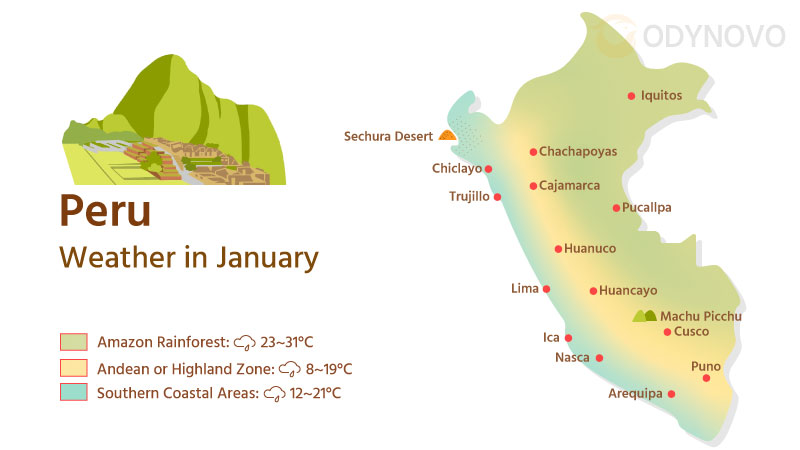 Map of Peru's Weather in January
Map of Peru's Weather in January
The weather in Peru in January varies from region to region. The coastal areas are warm and relatively dry, the highland zone is cool with rain, and the rainforests are very wet. It offers a good opportunity to enjoy the sun at the beach or take a boat ride into the rainforest.
The Southern Coastal Areas
January in Peru's southern coastal areas, such as Arequipa and Paracas, is warm and dry with occasional rainfall, and average temperatures of 12 to 21°C. Arequipa's volcanoes are worth exploring, and you can also visit buildings made of white volcanic rock and the Santa Catarina Monastery. In the Paracas Peninsula, you can enjoy the blend of coastline and desert landscapes and enjoy beach activities such as swimming and snorkeling.
The Andean or Highland Zone
January in Peru's Andean highlands, including Cusco and Machu Picchu, is warm, with rainfall mainly concentrated in the evening and night, and daytime temperatures usually between 8 to 19 ℃. You can explore the Inca ruins, such as Sacsayhuaman and the Inca Palace, and the rain does not affect the magnificent views of these mysterious monuments.
The Amazon Rainforest
January in the Peruvian Amazon rainforest, such as Iquitos, is hot and humid, with frequent rainfall and temperatures usually between 25 to 30 ℃. The humid environment of the rainy season promotes the activity of various plants and animals, providing opportunities for biological observation. You can take a boat tour of the Amazon River to enjoy the magnificent scenery of the wide water surface.
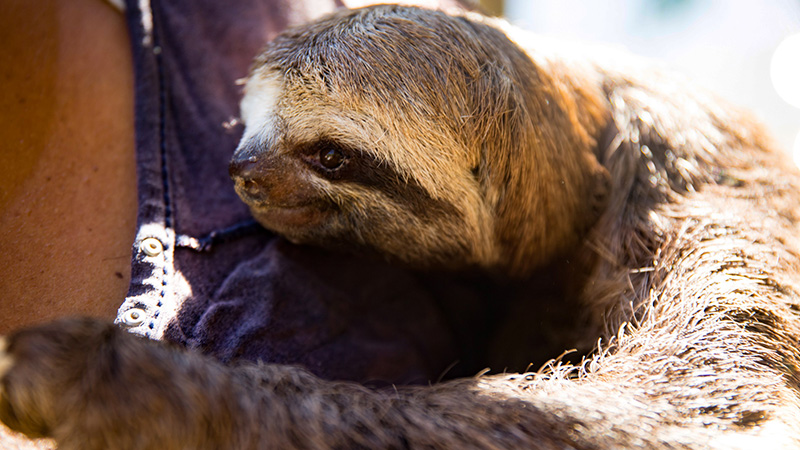 The Amazon Rainforest
The Amazon Rainforest
Best Places to Travel in January
Lima
January in Lima is the rainy season, and the weather is usually warm and humid, with occasional light rain. You can admire well-preserved colonial buildings such as the Cathedral of Lima and the Presidential Palace on the Plaza de Armas, and experience its unique Baroque architecture and ancient catacombs. In the seaside area, the Malconcha Park in the Miraflores district offers beautiful views of the Pacific Ocean, while the Barranco district is known for its artistic atmosphere and historical buildings.
Cusco
January is the rainy season in Cusco, but the air is fresh after the rain, and the surrounding natural landscape is particularly vibrant. The valleys and terraces of Cusco are shrouded in thick clouds, which sometimes disperse to reveal magnificent mountains and ancient Inca ruins, creating a mysterious and peaceful atmosphere, and you can go to Rainbow Mountain to experience the more vivid colors. In addition, the Sacred Valley is lush and green suitable for exploring Pisac.
Trujillo
January in Trujillo is warm and humid, with rainfall mainly concentrated at night. You can explore ancient sites such as the magnificent Chan Chan, a pre-Inca mud-brick city that showcases the splendor of ancient civilization, visit the Hucap ruins to admire the painted walls and carvings and experience the religious beliefs of the Inca. In addition, Las Delicias Beach is still suitable for relaxation, and you can enjoy the sun and beach or try water sports.
Arequipa
January is a great month to visit volcanoes in Arequipa. Arequipa is surrounded by Misti, Chachani, and Picha Picha volcanoes, which are particularly magnificent against the backdrop of blue sky and white clouds. From the top, you can see the panoramic view of Arequipa City, as well as the beautiful scenery of the surrounding plateaus, canyons, and green areas. In addition to volcanic exploration, Arequipa also has rich cultural attractions, such as the Santa Catarina Monastery, which is like a small city with colorful walls, quiet alleys, and exquisite gardens.
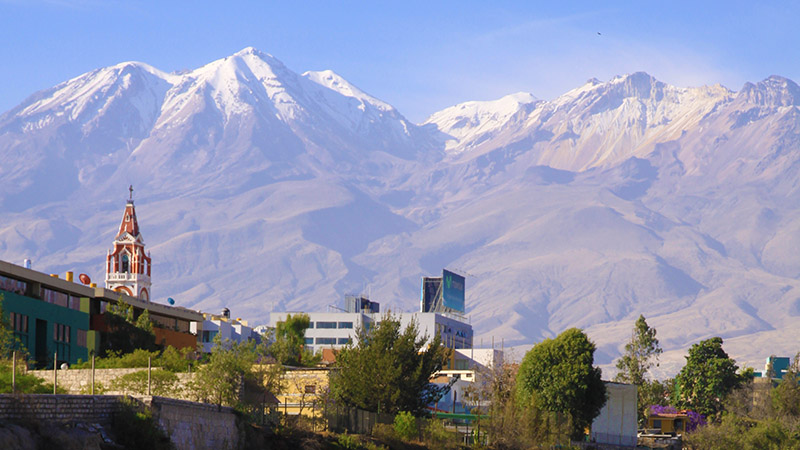 Arequipa
Arequipa
What to See & Do in January
Enjoy the Sun and Beaches
Peru's beaches are warm and pleasant in January. You can go to Mancora Beach in Lima, where the water is clear and the sand is white, suitable for water activities such as surfing, kayaking, and diving. At Picasso Beach, you can not only appreciate the works of art by various artists, but you can also try water sports such as surfing and paragliding on the beach. In Huanchaco, Trujillo, local fishermen use traditional "Caballitos de Totora" to fish at sea, and you can rent these unique boats and experience the ancient way of fishing.
Revel in Your Relaxing Evening
The weather in the coastal areas of Peru in January is pleasant at night, with a gentle sea breeze, perfect for a leisurely stroll. In Miraflores, Lima, you can enjoy the magnificent night view of the Pacific Ocean in Cliff Park, enjoy a quiet time in the cafe, taste authentic snacks, and enjoy live Latin music. In the Huanchaco fishing village of Trujillo, the beach is quiet and beautiful at night, and you can enjoy seafood, or join a night beach yoga class to feel the relaxing atmosphere. In Paracas, the nature reserve is starry at night, go desert off-roading, camp, and stargazing, or canoe in the bay to enjoy a unique experience of being one with nature.
Explore the Peruvian Rainforest by Boat
During the rainy season, the river level is usually higher, and you can take a boat to explore more rivers, streams, and wetlands. The vegetation is lush, and the birds and fish are active. You can see pink river dolphins, which are particularly conspicuous in the turbid water. They often appear in the shallow waters of the river to prey on fish. Besides, you may see colorful parrots and various birds such as falcons, grebes, and cormorants perching, hunting, or flying by the river. After the rain, you will see huge green leafy plants, trees with vines, and aquatic plants growing in the water, forming a fascinating picture of the rainforest. In addition to pink river dolphins and birds, you may also see sloths, monkeys, otters, crocodiles, etc. They may appear near the water, looking for food or enjoying the sun.
Unveil the Charm of Volcano
Although this season is the rainy season in Peru, southern Andes is relatively dry, especially in the high-altitude areas of the volcanoes. You can hike, horseback ride, or take a hot air balloon ride to go deep into the volcanic area and feel the power and beauty of nature. Arequipa's Misti Volcano is a cone-shaped active volcano. After you climb to the top, you can overlook the magnificent scenery of the entire city and its surroundings; Moquegua's Ubinas Volcano is an active volcano, and you can pass by ancient Inca ruins and admire the traces of volcanic activity; Cusco's Salkantay Volcano's hiking route crosses the Andes and tropical rainforests, and the natural scenery is magnificent.
Events & Festivals
New Year's Day
The Peruvian New begins the night before and continues into the first day of the new year, January 1st, with celebrations held in homes and public places across the country. At midnight, you'll see fireworks set off all over the country, lighting up the night sky. You can try a classic dinner, which often includes traditional Peruvian food such as roasted guinea pig, ceviche, and tortillas, and greet the new year with the locals. Remember to wear yellow clothes and accessories, as yellow symbolizes good luck. When the clock strikes midnight, eat 12 grapes, representing each month of the year, and make a wish for each grape to bring you good luck and happiness.
Chiaraje
Chiaraje is a unique traditional festival in Peru, celebrated in the Cusco region. The core of the celebration is a symbolic battle between two camps using stones and whips to represent the fight for land and resources, not to cause real harm. You will wear colorful traditional clothes made of wool and decorated with intricate patterns and decorations, symbolizing ethnicity and traditions. You can experience traditional Andean music and dance, which is played by charango, recorders, and drums, and dances that imitate natural phenomena and animal movements. Before and after the battle ceremony, participants offer offerings to Pachamama, Mother Earth, and other gods, such as food, alcoholic beverages, and spices, symbolizing respect and gratitude for nature, and praying for a good harvest and happiness in the coming year.
Festival of San Sebastian
San Sebastian Festival, held on January 20th in the San Sebastian district of Cusco, is a vibrant celebration of color and culture. It honors San Sebastian, the patron saint of farmers, with a grand mass and a lively procession featuring a beautifully decorated statue. You'll see participants dress in traditional costumes, sing hymns, and perform energetic dances like Waka Waka and Qhapaq Qolla, and you can enjoy traditional Andean music from charango, pan flutes, and drums. Street stalls offer local foods such as roasted guinea pig, tortillas, Ceviche, and Chicha, a unique corn drink.
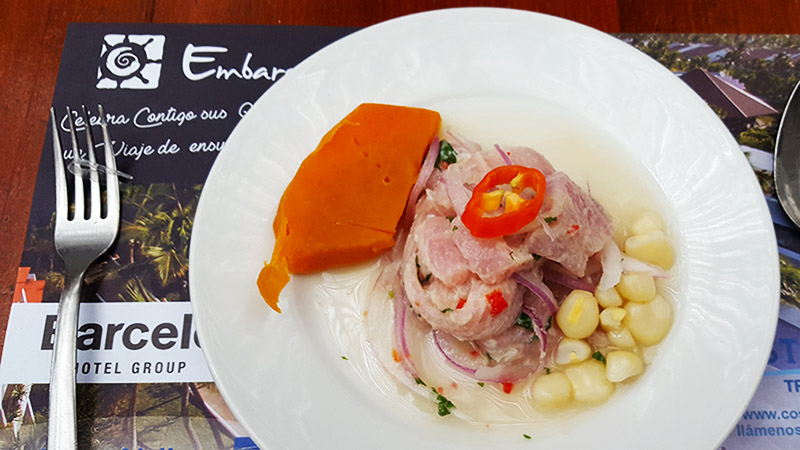 Ceviche
Ceviche
Crowds & Cost
January, the rainy season, is a quiet month in Peru. Hotels and traffic are generally lower, but Lima and other coastal cities are still popular destinations in January, and many tourists go to enjoy the warm sunshine and beautiful beaches, which makes accommodation and dining prices higher than usual.
In addition, during the holiday, flight and hotel prices are relatively high. If you are planning a trip to Peru in January, book in advance so that you can not only take advantage of the best deals and offers but also make it easier to arrange your trip during the peak holiday period.
Travel Tips for Traveling Peru in January
Dress in Layers
In January, the temperature in Peru varies greatly from morning to night, so it is recommended to dress in layers and add or remove clothing as the temperature changes. You can keep comfortable in a light T-shirt and a thin jacket during the day, and bring a jacket or sweater at night to keep warm when the weather turns cooler.
Prepare Basic Medicines
Peru's weather in January is changeable, which can easily lead to colds and fevers, so prepare antipyretics just in case. If you plan to go to high altitude areas such as Cusco, don't forget to bring anti-altitude sickness medicine to avoid headaches and nausea. Additionally, carry a small first aid kit with band-aids, disinfectant, and gauze to deal with emergencies.
Bring Rain Gear and Insect Repellents
January is the rainy season, bring a light raincoat or waterproof jacket in case of unexpected rainfall. What's more, the hot and humid weather provides good conditions for mosquitoes. Remember to bring insect repellents and spray them on exposed skin and clothes to avoid mosquito bites.
Discover the Charm of Peru in January With These Itineraries
8-Day History and Food Tour in Peru
This 8-day tour offers a mix of culinary and historical experiences. Apart from tasting regional dishes and learning to make a Pachamanca feast in Lima, Arequipa, and Cusco, you'll also explore the Inca heritage by visiting Machu Picchu, Sacsayhuaman, and Qenqo.
10-Day Peru Discovery with Amazon Rainforest
This trip blends history, adventure, stunning scenery, and Inca culture. You'll explore the Amazon rainforest, discover Cusco's historic sites like the Cathedral and Sacsayhuaman, and trek the Inca Trail to Machu Picchu. Then you'll see why Peru is an exceptional travel destination.
Quick Question
Related Posts You May Like
What Our Clients Say
Explore the latest verified reviews of Odynovo's travel services on Tripadvisor, Google, Trustpilot, Product Review and more trusted platforms.

